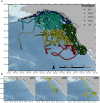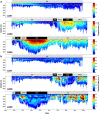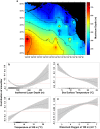Oceanographic drivers of the vertical distribution of a highly migratory, endothermic shark
- PMID: 28874881
- PMCID: PMC5585177
- DOI: 10.1038/s41598-017-11059-6
Oceanographic drivers of the vertical distribution of a highly migratory, endothermic shark
Abstract
Salmon sharks Lamna ditropis are highly migratory, upper trophic level predators in North Pacific ecosystems. We analysed a multi-year satellite tag dataset to investigate the habitat use of female salmon sharks across their broad range in the eastern North Pacific (NEP) and identified key environmental factors that influence vertical distribution. Salmon sharks displayed remarkable plasticity in habitat use across disparate oceanographic regions in the NEP and increased utilization of deeper waters in offshore habitats. Diel shifts in vertical distribution and behaviour were consistently observed across their range and likely reflect shifts in their foraging ecology. Salmon sharks utilized a broad thermal niche and exhibited submergence behaviour, possibly for thermal refuge, when encountering sea surface temperatures outside their preferred temperature distribution. Moreover, the vertical distribution of salmon sharks indicates they were able to exploit low dissolved oxygen environments (<1-3 ml l-1), occasionally for extended periods of time in offshore habitats. However, salmon sharks generally reduced their use of deeper waters when encountering the combination of cold temperatures (<6 °C) and low dissolved oxygen concentrations (<1-3 ml l-1). Combining vertical distribution with high-resolution horizontal movements furthers our understanding of the ecological and environmental drivers of movement across short (diel) and long-term (migratory) scales.
Conflict of interest statement
The authors declare that they have no competing interests.
Figures








Similar articles
-
White shark offshore habitat: a behavioral and environmental characterization of the eastern Pacific shared offshore foraging area.PLoS One. 2009 Dec 9;4(12):e8163. doi: 10.1371/journal.pone.0008163. PLoS One. 2009. PMID: 20011032 Free PMC article.
-
Spatial dynamics and expanded vertical niche of blue sharks in oceanographic fronts reveal habitat targets for conservation.PLoS One. 2012;7(2):e32374. doi: 10.1371/journal.pone.0032374. Epub 2012 Feb 29. PLoS One. 2012. PMID: 22393403 Free PMC article.
-
Satellite tagging and cardiac physiology reveal niche expansion in salmon sharks.Science. 2005 Oct 7;310(5745):104-6. doi: 10.1126/science.1114616. Science. 2005. PMID: 16210538
-
Diet Composition and Trophic Ecology of Northeast Pacific Ocean Sharks.Adv Mar Biol. 2017;77:111-148. doi: 10.1016/bs.amb.2017.06.001. Epub 2017 Aug 18. Adv Mar Biol. 2017. PMID: 28882212 Review.
-
The biology and ecology of the basking shark: A review.Adv Mar Biol. 2023;95:113-257. doi: 10.1016/bs.amb.2023.08.005. Epub 2023 Oct 28. Adv Mar Biol. 2023. PMID: 37923538 Review.
Cited by
-
Diving into the vertical dimension of elasmobranch movement ecology.Sci Adv. 2022 Aug 19;8(33):eabo1754. doi: 10.1126/sciadv.abo1754. Epub 2022 Aug 19. Sci Adv. 2022. PMID: 35984887 Free PMC article.
-
Extensive oceanic mesopelagic habitat use of a migratory continental shark species.Sci Rep. 2022 Feb 7;12(1):2047. doi: 10.1038/s41598-022-05989-z. Sci Rep. 2022. PMID: 35132104 Free PMC article.
-
Novel CTD tag establishes shark fins as ocean observing platforms.Sci Rep. 2024 Jun 15;14(1):13837. doi: 10.1038/s41598-024-63543-5. Sci Rep. 2024. PMID: 38879656 Free PMC article.
-
Climate-driven deoxygenation elevates fishing vulnerability for the ocean's widest ranging shark.Elife. 2021 Jan 19;10:e62508. doi: 10.7554/eLife.62508. Elife. 2021. PMID: 33461659 Free PMC article.
-
Temperature and the vertical movements of oceanic whitetip sharks, Carcharhinus longimanus.Sci Rep. 2018 May 29;8(1):8351. doi: 10.1038/s41598-018-26485-3. Sci Rep. 2018. PMID: 29844605 Free PMC article.
References
-
- Maxwell SM, et al. Dynamic ocean management: defining and conceptualizing real-time management of the ocean. Marine Policy. 2015;58:42–50. doi: 10.1016/j.marpol.2015.03.014. - DOI
-
- Braccini M, Aires-da-Silva A, Taylor I. Incorporating movement in the modelling of shark and ray population dynamics: approaches and management implications. Reviews in Fish Biology and Fisheries. 2015;26:13–24. doi: 10.1007/s11160-015-9406-x. - DOI
-
- Nagasawa K. Predation by salmon sharks (Lamna ditropis) on Pacific salmon (Oncorhynchus spp) in the North Pacific Ocean. North Pacific Anadromous Fish Commission Bulletin. 1998;1:419–433.
-
- Brodeur R, et al. Epipelagic nekton of the North Pacific Subarctic and Transition Zones. Progress in Oceanography. 1999;43:365–397. doi: 10.1016/S0079-6611(99)00013-0. - DOI
Publication types
MeSH terms
LinkOut - more resources
Full Text Sources
Other Literature Sources

